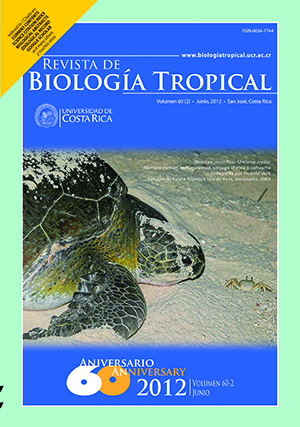Abstract
Treatment with the usual antimalarial drugs, have induced parasite resistance, reinforcing the need to finding natural antimalarial components that would be found on plants from the forest. Therefore, we decided to look for these components in Costa Rican plants from a protected forest area. Fresh and dry extracts of roots, bark, leaves, flowers and fruits of 25 plants from a biological reserve in Costa Rica, Reserva Biológica Alberto Manuel Brenes (REBAMB), were studied in vitro for the presence of substances with antimalarial activity. By studying the inhibition of P. berghei schizogony, we assessed the antimalarial activity of several plant extracts: Aphelandra aurantiaca, A. tridentata (Acanthaceae); Xanthosoma undipes (Araceae); Iriartea deltoidea (Arecaceae); Neurolaena lobata (Asteraceae); Senna papillosa, Pterocarpus hayessi, Lonchocarpus pentaphyllus (Fabaceae); Nectandra membranacea, Persea povedae, Cinamomum chavarrianum (Lauraceae); Hampea appendiculata (Malvaceae); Ruagea glabra, Guarea glabra (Meliaceae); Psidium guajava (Myrtaceae); Bocconia frutescens (Papaveraceae); Piper friedrichsthalii (Piperaceae); Clematis dioica (Ranunculaceae); Prunus annularis (Rosaceae); Siparuna thecaphora (Siparunaceae); Solanum arboreum, Witheringia solanacea (Solanaceae); Ticodendrum incognitum (Ticodendraceae); Heliocarpus appendiculatus (Tiliaceae) and Myriocarpa longipes (Urticaceae). We used different parts of the plants as well as fresh and dried extracts for testing IC50. The solid content of the extracts ranged from 1-71.9μg/mL. The fresh extracts showed stronger activity than the dry ones. Since the plants showing the strongest antimalarial activity are very common in Central America, and some similar genera of these plants have shown positives results in South America, we considered important to present these findings for discussion. On the other hand, this is the first systematic study of this kind ever realized in a circumscribed and protected area of Costa Rica.
This work is licensed under a Creative Commons Attribution 4.0 International License.
Copyright (c) 2012 Revista de Biología Tropical

